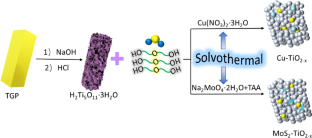Carbon Letters ( IF 4.5 ) Pub Date : 2024-04-23 , DOI: 10.1007/s42823-024-00731-3 Xiao Liu , Shuo Li , Liangliang Li , Gang Cheng

|
Photocatalytically splitting water into hydrogen upon semiconductors has tremendous potential for alleviating environmental and energy crisis issues. There is increasing attention on improving solar light utilization and engineering photogenerated charge transfer of TiO2 photocatalyst because it has advantages of low cost, non-toxicity, and high chemical stability. Herein, oxygen vacancies and cocatalysts (Cu and MoS2) were simultaneously introduced into TiO2 nanoparticles from protonic titanate by a one-pot solvothermal method. The composition and structure characterization confirmed that the pristine TiO2 nanoparticle was rich in oxygen vacancies. The photocatalytic performances of the composites were evaluated by solar-to-hydrogen evolution test. The results revealed that both Cu-TiO2 and MoS2-TiO2 could improve the photocatalytic hydrogen evolution ability. Among them, 0.8% Cu-TiO2 showed the best hydrogen evolution rate of 7245.01 μmol·g−1·h−1, which was 3.57 and 1.34 times of 1.25% MoS2-TiO2 (2726.22 μmol·g−1·h−1) and pristine TiO2 material (2028.46 μmol·g−1·h−1), respectively. These two kinds of composites also had good stability for hydrogen evolution. Combined with the results of photocurrent density and electrochemical impedance spectra, the incorporation of oxygen vacancies and cocatalysts (Cu and MoS2) could not only enhance the light-harvesting of TiO2 but also improve the separation and transfer capabilities of light-induced charge carriers, thus promoting water splitting to hydrogen.
中文翻译:

将氧空位和助催化剂共同引入质子钛酸盐衍生的 TiO2 纳米颗粒中,以增强光催化产氢
在半导体上光催化将水分解为氢对于缓解环境和能源危机问题具有巨大的潜力。由于TiO 2光催化剂具有成本低、无毒、化学稳定性高等优点,提高太阳光利用率和工程光生电荷转移越来越受到人们的关注。在此,通过一锅溶剂热法将氧空位和助催化剂(Cu和MoS 2)同时引入质子钛酸盐的TiO 2纳米颗粒中。组成和结构表征证实原始TiO 2纳米粒子富含氧空位。通过太阳能析氢试验评估了复合材料的光催化性能。结果表明Cu-TiO 2和MoS 2 -TiO 2均能提高光催化析氢能力。其中0.8% Cu-TiO 2的析氢速率最好,为7245.01 μmol·g -1 ·h -1,分别是1.25% MoS 2 -TiO 2 (2726.22 μmol·g -1 · h -1 )的3.57和1.34倍。 -1 )和原始TiO 2材料(2028.46 μmol·g -1 ·h -1 )。这两种复合材料也具有良好的析氢稳定性。结合光电流密度和电化学阻抗谱的结果,氧空位和助催化剂(Cu和MoS 2 )的掺入不仅可以增强TiO 2的光捕获能力,还可以提高光生载流子的分离和传输能力。 ,从而促进水分解为氢气。



























 京公网安备 11010802027423号
京公网安备 11010802027423号